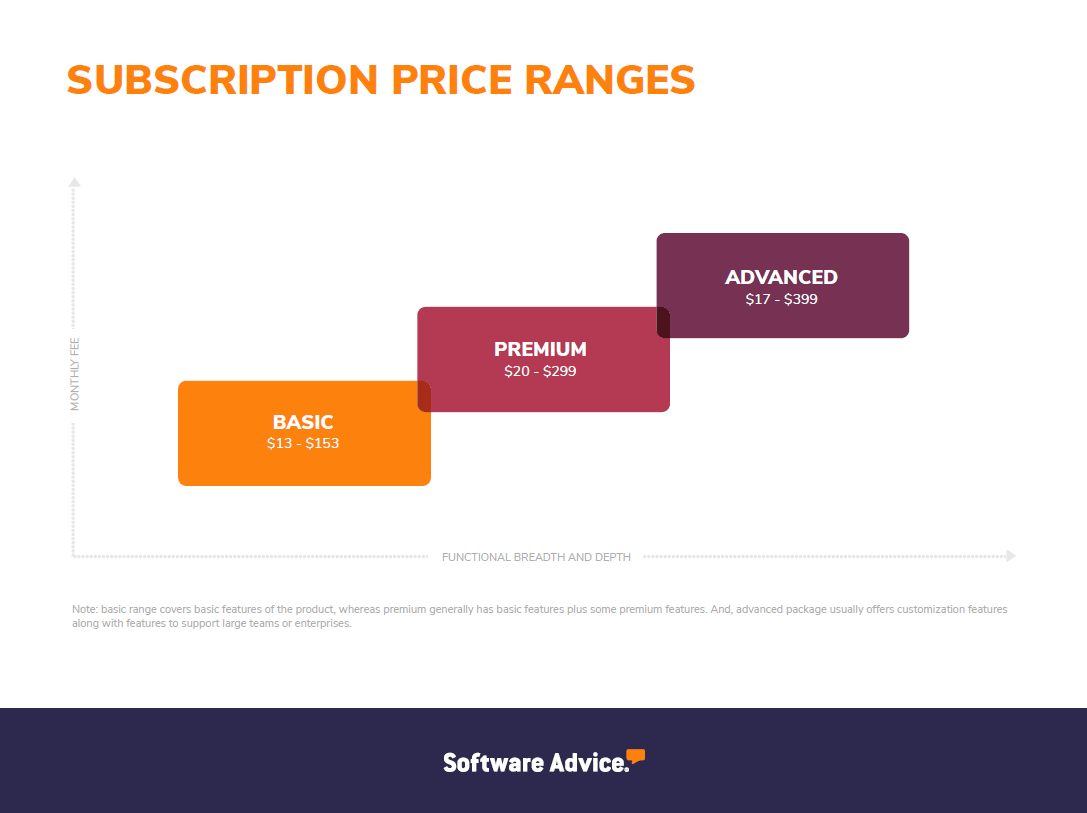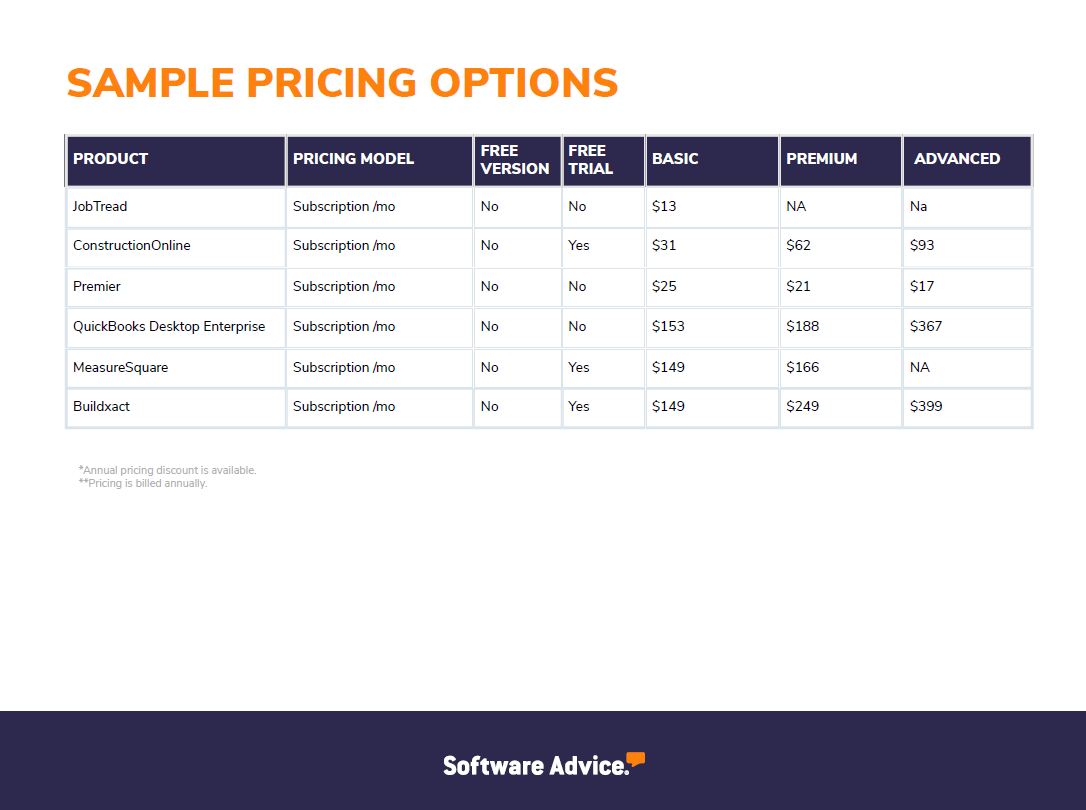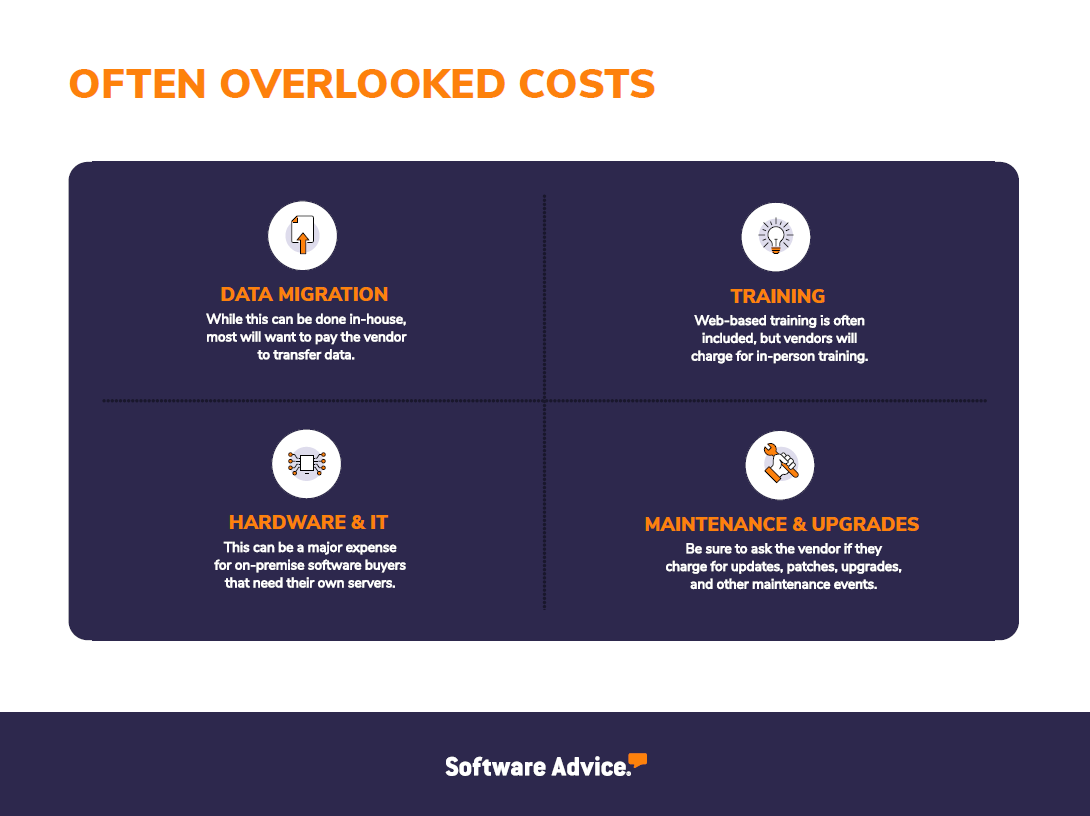A Guide to Construction Estimating Software Pricing Models
Multiple pricing plans with a range of features, such as artificial intelligence (AI) capabilities, project scheduling, and collaboration, may attract you. Still, as a general contractor, you need to decide whether you need all of these features. Carefully understanding your needs and finding the right plan that fulfills your requirements will help you make a cost-effective decision when purchasing a construction estimation tool.
To help you make a well-informed decision, we’ve put together this comprehensive guide so that you can understand and compare construction estimating software prices. These insights will help you determine which pricing plan best fits your needs.
How is construction estimating software priced?
Construction estimation software offers multiple pricing models typically based on the number of features offered in a particular plan. Factors such as the number of users, available storage capacity, and offered support options also influence the pricing ranges.
Types of construction estimating software pricing models
Construction estimating software is most commonly available on a subscription-based pricing model wherein the users pay a recurring fee to the software vendor on a monthly or yearly basis. These subscription models are divided into different plans, such as:
Freemium: Offers a free version of the software to a small number of users or with a limited set of construction estimating features, typically catering to small businesses or small teams with basic construction estimating requirements.
Basic: Starting at $13 per month, this plan suits businesses with 1-100 employees. The basic plan offers features such as cost estimation and construction templates.
Premium: The premium plan starts at $20 and goes up to $299. Serving up to 250 users, this mid-range price category offers more advanced features such as collaboration and bid management.
Advanced: Costing $399+ and serving 251 minimum users, the plan offers the most advanced construction estimation features, including advanced cost analysis, project scheduling, and mobile access.

For reference, below is a snapshot of the costs of some popular construction estimating software.

A note on features
Construction estimating software helps calculate the costs associated with a construction project. It automates the process of estimating materials, labor, equipment, and other expenses, helping construction professionals and contractors generate accurate project cost estimates. However, the tool must offer a cost database, job costing, and proposal generation as core features to qualify as a construction estimating tool.
What are the upfront and recurring costs associated with construction estimating software?
Upfront costs are the expenses incurred while purchasing or subscribing to the software. These include licensing costs, installation expenses, and training costs. On the other hand, costs such as subscription fees and maintenance costs are called recurring costs because a user has to incur them on a monthly or yearly basis to continue to use the software.
Let’s look at upfront and recurring costs under the different construction software pricing models before deciding on the software implementation.

Subscription license | Perpetual license | Free plans | |
|---|---|---|---|
What it is: | This is a monthly or annual fee that the users have to pay as long as they wish to use the software. The pricing is mostly based on the number of users of the software in a month. | In a perpetual license plan, the users have to pay a one-time fee for a permanent license to use the construction software. The amount of this license can vary depending on the number of users of construction management software. | Free plans offer the construction estimating tool free of any cost but only include basic construction estimating software features. |
Commonly used for: | This kind of license is commonly used for cloud-based deployments, where the system is hosted by vendors on their servers and can be accessed on compatible devices over the internet. | Perpetual license is suitable for on-premise deployments, where the system is hosted and maintained in-house on the user’s own servers. | Free plans are more suitable for small builders or contractors with a limited budget and resources. |
Upfront costs: | Installation and setup, customization of the software, and integration with existing systems are the most common upfront costs associated with subscription plans. | Upfront costs associated with a perpetual license are a one-time license fee, customization costs, and hardware (for example, server costs). | The only upfront cost in a free plan is the installation and setup of the solution. |
Recurring costs: | Monthly subscription fees, starting from $13 per month, and charges for premium support services such as live chat and 24-7 phone support are two common recurring costs in a subscription license. | Monthly, annual, or ad hoc maintenance (for example, updates, patches, and upgrades) of the solution and premium support offerings (for example, extended phone support hours) may lead to recurring costs under this license. | There are no recurring costs in a free construction estimation software plan. |
Hidden costs: | Subscription licenses can have hidden costs, such as the cost to increase the storage capacity, create more automated workflows, or implement company branding. | Hiring IT staff or the salaries of the IT staff who will work on the maintenance of the construction estimating software can be a hidden cost associated with a perpetual license. | Customization, integration with existing tech stack, training, and premium support options may be some associated hidden costs of a free plan. |
What are the additional fees associated with construction estimating software?
Understanding additional fees that you may have to incur while implementing construction estimation software is as important as understanding the various pricing models. These costs are common across vendors, and it's a good idea to include them in your budget.

Data migration: If you're currently using construction management software and are considering switching to a different one, it's important to take into account the expenses related to data migration. The process of moving your data can be time-consuming, and you might need to consult with an expert to ensure proper data mapping and data integrity. Additionally, there could be some downtime during the data transfer, which could impact your business operations. It's essential to carefully consider these factors when calculating the costs associated with data migration.
Training: If your team isn't at ease with the construction estimating tool you roll out, they won't be able to make the most of it. Fortunately, many software providers provide support materials like knowledge bases, FAQs, and video tutorials to help you grasp the ins and outs of the tool. Assess whether these resources are adequate or if extra training is necessary. While additional training may incur expenses upfront, it'll ultimately empower your staff to handle complex tasks with ease using the tool, making it a worthwhile investment.
Hardware and IT: Consider the possibility of upgrading your servers to accommodate the construction estimation tool on your team's computers or mobile devices, ensuring their devices meet the tool's technical specifications. Additionally, you might need to bring in an IT specialist to handle ongoing maintenance. These expenses will increase your overall investment in the construction estimation software, so it's crucial to conduct a thorough evaluation of your existing IT infrastructure before making a commitment to a specific tool.
Maintenance and upgrades: Routine upkeep and enhancements for the construction estimating platform are vital for preventing downtime or technical glitches that could disrupt business operations and ensure the software operates smoothly. However, it's worth noting that these maintenance tasks, upgrades, and patches might not be included in the vendor's license or subscription, potentially requiring separate purchases. Another option is hiring an in-house IT manager for tool maintenance. Carefully evaluate both alternatives to determine which offers the most cost-effective solution for your specific needs.
How to find the right construction estimating software price range
1. Define your needs. Start by understanding your specific needs, project scale, and workflow. When you can pinpoint your exact needs, you can match them with the features offered by construction cost estimating software in different price ranges. This ensures you don't overspend on features you won't use or compromise critical functionalities due to budget constraints. Tailoring your choice to your specific needs helps you make a cost-effective decision.
2. Analyze pricing plans. Thoroughly examine the pricing structure of the software you’re considering. Look for transparency in pricing, including one-time fees, subscription models, or additional costs for advanced features or user licenses. Compare the pricing plans of different software options to ensure they align with your budget and long-term financial expectations.
3. Consider scalability. Assess whether the construction cost estimating software can adapt to your evolving needs. While a software solution may meet your current requirements, it's essential to evaluate whether it can accommodate the growth of your projects or business without incurring significantly higher costs. Scalable software allows you to expand your usage, add more users, or access advanced features as your construction estimating needs evolve, ensuring a cost-effective and sustainable solution.
Common questions to ask when choosing a construction estimating software pricing plan
Does the tool have a free trial or demo version? A free trial or a demo version will let you have hands-on experience to assess the software’s user-friendliness, features, and compatibility with your workflow. It will minimize the risk of you investing in a software solution that may not meet your requirements, ensuring a more informed and cost-effective decision.
Is there an open source version of the tool? Open source construction estimating software will give you access to a community-driven solution. You will be able to assess the tool’s capabilities, customize it to your unique requirements, and contribute to its improvement. This approach will significantly reduce your software expenses while fostering innovation and adaptability
Does the tool have any add-ons? Construction cost estimating tool add-ons allow you to enhance functionality and tailor the software to your specific requirements. You can identify whether essential features or integrations you need are available through add-ons, potentially saving time and money compared to custom development.
Find the best construction estimating software packages
Do the construction estimating tools listed in this guide fall within your software budget? If so, compare their features and read real user reviews of more than 1,000 similar products listed on our construction estimating software category page.
Sources
The products in this guide qualified for the most recent FrontRunners for construction estimating and were highly rated by users. Only products with publicly available pricing information were included in this table. We summarized publicly available pricing sources, including vendor websites as of September 2023, beginning with the lowest monthly pricing (not including annual discounts) for packages that include the core functionality for a software category. We list pricing for more advanced packages (per user, when available) that include the core software feature(s). Your company's needs may differ, and final pricing may vary.
Note: This article is intended to inform our readers about business-related concerns in the U.S. It is in no way intended to provide financial advice or to endorse a specific course of action. For advice on your specific situation, consult your accountant or financial consultant.